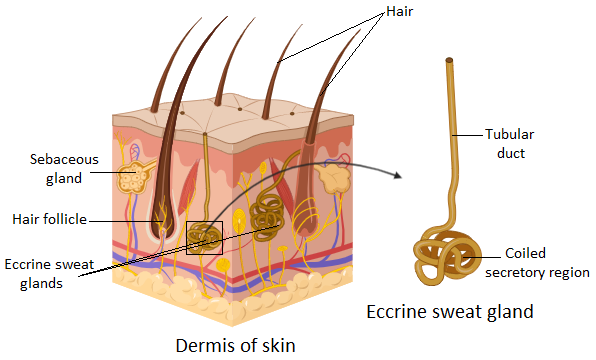
Simple coiled tubular glands are found in
A. Dermis of skin
B. Kidney
C. Liver
D. Spleen
Answer
548.7k+ views
Hint:Glands are secretory structures that produce various important biological secretions. The coiled tubular glands are made of a very long and unbranched duct. This duct continues with the coiled portion which is the secretory portion. An example of this is the eccrine sweat gland.
Complete answer:Glands are structures of cells that synthesize and secrete substances such as hormones, oils, sweat, etc. either inside the body or on its outer surface. There are two major types of glands. These are called exocrine glands and endocrine glands. The endocrine gland products circulate along with the bloodstream whereas exocrine gland products are secreted through a duct. The secretion of exocrine glands passes through ducts that terminate either externally to the skin or internally to organs.

Simple coiled tubular glands have a very long duct which is a cylindrical structure. The duct terminates outside the skin surface and thus it is an exocrine gland. The base of the coiled tubular gland is coiled and it is the main secretory region. These glands are usually unbranched. An example of these glands is the eccrine gland. It is the major sweat gland that lies in the dermis layer of the skin. All of the skin consists of these glands. Palm, head, and sole regions contain these glands in high density. Their secretion is a clear odorless substance called sweat. It primarily consists of water. The secretions are excreted through sweat pores on the skin.
Therefore, from the above discussion, we can conclude that the right answer is option A.
Note: The coiled portion of the simple coiled tubular glands is made of two concentric layers of columnar or cuboidal epithelial cells. Myoepithelial cells interpose the underlying epithelial cells. Above the myoepithelial cells lie the secretory epithelial cells.
Complete answer:Glands are structures of cells that synthesize and secrete substances such as hormones, oils, sweat, etc. either inside the body or on its outer surface. There are two major types of glands. These are called exocrine glands and endocrine glands. The endocrine gland products circulate along with the bloodstream whereas exocrine gland products are secreted through a duct. The secretion of exocrine glands passes through ducts that terminate either externally to the skin or internally to organs.

Simple coiled tubular glands have a very long duct which is a cylindrical structure. The duct terminates outside the skin surface and thus it is an exocrine gland. The base of the coiled tubular gland is coiled and it is the main secretory region. These glands are usually unbranched. An example of these glands is the eccrine gland. It is the major sweat gland that lies in the dermis layer of the skin. All of the skin consists of these glands. Palm, head, and sole regions contain these glands in high density. Their secretion is a clear odorless substance called sweat. It primarily consists of water. The secretions are excreted through sweat pores on the skin.
Therefore, from the above discussion, we can conclude that the right answer is option A.
Note: The coiled portion of the simple coiled tubular glands is made of two concentric layers of columnar or cuboidal epithelial cells. Myoepithelial cells interpose the underlying epithelial cells. Above the myoepithelial cells lie the secretory epithelial cells.
Recently Updated Pages
Master Class 12 Business Studies: Engaging Questions & Answers for Success

Master Class 12 Economics: Engaging Questions & Answers for Success

Master Class 12 English: Engaging Questions & Answers for Success

Master Class 12 Maths: Engaging Questions & Answers for Success

Master Class 12 Social Science: Engaging Questions & Answers for Success

Master Class 12 Chemistry: Engaging Questions & Answers for Success

Trending doubts
What is meant by exothermic and endothermic reactions class 11 chemistry CBSE

Which animal has three hearts class 11 biology CBSE

10 examples of friction in our daily life

One Metric ton is equal to kg A 10000 B 1000 C 100 class 11 physics CBSE

1 Quintal is equal to a 110 kg b 10 kg c 100kg d 1000 class 11 physics CBSE

Difference Between Prokaryotic Cells and Eukaryotic Cells




